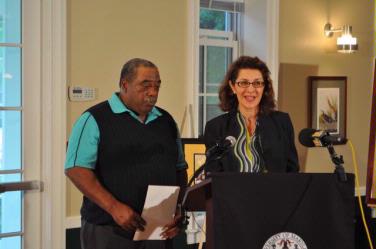Study Shows Success in Targeting Heart Disease
Two-year, $1 million study used unique “train the trainer” approach to improve blood pressure levels among high-risk patients

By Steve Berberich
September 28, 2010
A new model for health networking by the University of Maryland School of Pharmacy shows that twice as many participants with high blood pressure in an “intervention group” reached safe blood pressure levels than participants without the intervention.
The health networking model was born out of an experiment called the Maryland Cardiovascular Promotion (MVP) Program. It was funded by a $1 million grant from CareFirst BlueCross BlueShield targeting high blood pressure in African-American males in Baltimore.
Results of the study were released at a news conference Sept. 27, at the Forest Park Golf Course in Baltimore where the golf professional was a participant in the study.
The MVP Program was called “revolutionary” by Natalie D. Eddington, PhD, dean of the School of Pharmacy, because patients themselves through networking among friends and family recruited other patients and pharmacists acted as expert coaches, educating patients on the dangers of hypertension (high blood pressure) and how to talk with their physicians.
“I’m proud that the School of Pharmacy is reaching beyond its walls to the community around us in an effort to improve the health of our neighbors,” said Eddington. “The MVP Program is a prime example of what pharmacists, as one of the most accessible members of the health care team, can do for their own communities. This is a program that we hope to see duplicated and expanded in the city of Baltimore and in the state of Maryland.”
The MVP Program was pronounced a success by the chair of its advisory board, Elijah Saunders, MD, the head of the Section of Hypertension in the Division of Cardiology at the University of Maryland School of Medicine. “This was an experiment in which we could have predicted the results, but we needed proof,” said Saunders. “Now it’s up to the state and federal governments to apply this model and make it work. It should be applied so that we can save money and save lives.” As soon as the MVP Program results are published in medical journals, word will spread to other institutions and communities, said Saunders.
The director of Minority Health and Health Disparities at the Maryland Department of Health and Mental Hygiene, Carlessia Hussein, RN, DrPH, said she learned a lot from the MVP Program experiment and plans to implement the model. “The MVP Program has some great data that shows that such a community program can really work,” she said.
Nearly 600 patients enrolled in the MVP Program. Pharmacists and nurses provided initial blood pressure tests and health consulting. Half of the patients, the control group, were given periodic blood pressure testing only. The other half, or “intervention” patients, also had vital signs assessed, attended a class to learn how to maintain healthy lifestyles, and were counseled on management of the medications.
“We also empowered them to ask the right questions of their doctors while learning about their individual medication management,” said Fadia Shaya, PhD, MPH, MVP Program director and associate professor of pharmaceutical health services research in the School of Pharmacy.
Shaya said it isn’t difficult to treat patients to reduce risk of cardiovascular disease, which often begins with treating hypertension. But too many African-American men don’t get diagnosed until heart attacks or strokes put them in the emergency room or worse.
The stroke death rate among black Baltimoreans is 32 percent higher than for white Baltimoreans. Making just a 5-point drop in a patient’s systolic blood pressure reduces risk of stroke by 30 percent and the risk of mortality by 13 percent.
“MVP demonstrated that when patients understand the information available to them, it sticks and translates into improved outcomes,” said Shaya.
One MVP patient, Rafiq Rashid, 57, of Baltimore, was surprised to learn he had a systolic pressure higher than 150 when he was tested by the MVP Program clinical nurse Clyde Foster, RN, of the School of Pharmacy. Rashid’s family has a history of high blood pressure and diabetes, he said.
Foster taught Rashid what to ask his physician who, in turn, prescribed proper medication. Rashid attended some MVP classes and his systolic rate is well below 120 now. “It went down a lot and at one point I thought it was kind of scary, but my doctor said, ‘That’s really good.’ It worked for me so I’ve told people I know and associated with,” said Rashid.
About one in three adults in the United States has high blood pressure, according to the National Heart, Lung, and Blood Institute. It is a serious condition that can lead to coronary heart disease, heart failure, stroke, kidney failure, and other health problems. High blood pressure itself usually has no symptoms and people often live with it for years without knowing it, while it can be damaging the heart, blood vessels, kidneys, and other parts of the body.
